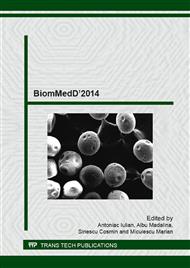[1]
J.A. Disegi, L. Eschbach, Stainless steel in bone surgery, Injury 31, S-D2-6, (2000).
DOI: 10.1016/s0020-1383(00)80015-7
Google Scholar
[2]
I. Antoniac, Biologically responsive biomaterials for tissue engineering, Ed. Springer, ISBN 978-1-4614-4327-8, (2013).
Google Scholar
[3]
F. Purghel, R. Badea, I. Antoniac, Medical Notion for Engineers (in romanian), Ed. Printech, Bucharest, ISBN 973-652-358-6, (2001).
Google Scholar
[4]
I. Antoniac, D. Laptoiu, A.I. Blajan, C. Cotrut, Instruments and Medical Devices (in romanian), Ed. Printech, Bucharest, ISBN 978-606-521-665-5, (2011).
Google Scholar
[5]
I. Antoniac, A. Necsulescu, G. Cosmeleata, Biomaterials and shape memory alloys, in Materials Science and Engineering Handbook (in romanian), Ed. AGIR, ISBN 978-973-720-261-1, (2009).
Google Scholar
[6]
Fini M., Aldini N.N., Torricelli P., Giavaresi G., Borsari V., Lenger H., Bernauer J., Giardino R., Chiesa R, Cigada A., A new austenitic stainless steel with negligible nickel content: an in vitro and in vivo comparative investigation, Biomaterials 24, 4929-4939, (2003).
DOI: 10.1016/s0142-9612(03)00416-2
Google Scholar
[7]
Wang K., The use of titanium for medical applications in the USA, Mater Sci. Eng. A 213, 134-137, (1996).
Google Scholar
[8]
Mihaela MA; Brandusa G; Nicolae G; Iuliac A (Iulian Antoniac), Corrosion Behaviour in Ringer Solution of Ti-Mo Alloys used for Orthopaedic Biomedical Applications, Solid State Phenomena, Volume 188 (2012) 98-101.
DOI: 10.4028/www.scientific.net/ssp.188.98
Google Scholar
[9]
Togan V., Ionita G., Antoniac I., Corrosion Behavior of Ti6Al4V Coated with SiOx by PECVD Technology, Key Engineering Materials, vol. 583, pp.22-27, (2014).
DOI: 10.4028/www.scientific.net/kem.583.22
Google Scholar
[10]
Reclaru L; Unger RE; Kirkpatrick CJ; Susz C; Eschler PY; Zuercher MH; Antoniac I; Lüthy H; Ni-Cr based dental alloys; Ni release, corrosion and biological evaluation, Materials Science and Engineering C-Materials for Biological Application 32 (2012).
DOI: 10.1016/j.msec.2012.04.025
Google Scholar
[11]
Miculescu F; Miculescu M; Ciocan LT; Ernuteanu A; Antoniac I; Pencea I; Matei E; Comparative studies regarding heavy elements concentration in human cortical bone, Dig. J. Nanomat. Biostruct. 6 (2011) 1117-1127.
DOI: 10.4028/www.scientific.net/ssp.188.37
Google Scholar
[12]
Miculescu F; Bojin D; Ciocan LT; Antoniac I; Miculescu M; Miculescu N; Experimental researches on biomaterial-tissue interface interactions, Journal of Optoelectronics and Advanced Materials, 9 (2007), 3303-3306.
DOI: 10.4028/www.scientific.net/kem.638.14
Google Scholar
[13]
I. Antoniac, M. Miculescu, M. Dinu, Metallurgical characterization of some magnesium alloys for medical applications, Solid State Phenomena, 188 (2012) 109-113.
DOI: 10.4028/www.scientific.net/ssp.188.109
Google Scholar
[14]
Antoniac I; Vranceanu MD; Antoniac A; The influence of the magnesium powder used as reinforcement material on the properties of some collagen based composite biomaterials, Journal of Optoelectronics and Advanced Materials 15 (2013) 667-672.
Google Scholar
[15]
Chen CE, Weng LH, Ko JY, Wang CJ.: Management of nonunion associated with broken intramedullary nail of the femur. Orthopedics. 31 (2008) 78.
DOI: 10.3928/01477447-20080101-07
Google Scholar
[16]
Akeson WH et al.: The effects of rigidity of internal fixation plates on long bone remodelling: a biomechanical and quantitative study. Acta Orthop. Scand 47 (1976) 241-242.
Google Scholar
[17]
Sloten, J. V., Labey, L., Van Audekercke, R., Van der Perre, G, Materials selection and design for orthopaedic implants with improved long-term performance, Biomaterials 19 (1998) 1455-1459.
DOI: 10.1016/s0142-9612(98)00058-1
Google Scholar
[18]
Pohler, O. E. M.: Degradation of metallic orthopedic implants, in Biomaterials in Reconstructive Surgery, (Ed L. R. Rubin), Mosby, London, UK, 158-228 (1983).
Google Scholar
[19]
E. Proverbio and L.M. Bonaccorsi: Microstructural Analysis of Failure of a Stainless Steel Bone Plate Implant, Practical Failure Analysis 1 (2001) 33-38.
DOI: 10.1007/bf02715331
Google Scholar
[20]
Triantafyllidis G. K., Kazantzis A. V., Karageorgiou K. T.: Premature fracture of a stainless steel 316L orteopaedic plate implant by alternative episodes of fatigue and cleavage decoherence, Engineering Failure Analysis 14 (2007) 1346-1350.
DOI: 10.1016/j.engfailanal.2006.11.010
Google Scholar
[21]
Wouters, R., Froyen, L.: Scanning electron microscope fractography in failure analysis of steels. Mater. Charact. 36 (1996) 357-364.
DOI: 10.1016/s1044-5803(96)00070-8
Google Scholar
[22]
Azevedo, C.R.F., Hippert Jr, E.: Failure analysis of surgical implants in Brazil. Eng Fail. Anal. 9 (2002) 621-633.
DOI: 10.1016/s1350-6307(02)00026-2
Google Scholar
[23]
Sharma C. A., Ashok Kumar M. G., Joshi G. R., John J. T.: Retrospective Study of Implant Failure in Orthopaedic Surgery, MJAFI 62 (2006) 70-72.
Google Scholar
[24]
R. Ionescu, I. Cristescu, M. Dinu, R. Saban, I. Antoniac, D. Vilcioiu, Clinical, Biomechanical and Biomaterials Approach in the Case of Fracture Repair Using Different Systems Type Plate-Screw, Key Engineering Materials 583 (2014) 150-154.
DOI: 10.4028/www.scientific.net/kem.583.150
Google Scholar
[25]
M. Bane, F. Miculescu, A.I. Blajan, M. Dinu, I. Antoniac, Failure analysis of some retrieved orthopedic implants based on materials characterization, Solid State Phenomena 188 (2012) 114-117.
DOI: 10.4028/www.scientific.net/ssp.188.114
Google Scholar
[26]
D. Petković, G. Radenković, M. Mitković, Fractographic investigation of failure in stainless steel orthopedic plates, Facta Universitatis, Series: Mechanical Engineering 10, (2012) 7-14.
Google Scholar


